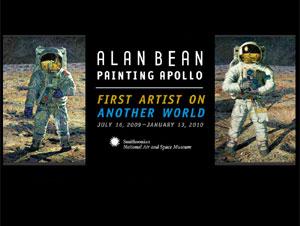Moon art from someone who’s been there
The following is not a full transcript; for full story, listen to audio.
It’s been almost 40 years since a human first walked on the moon. Neil Armstrong made that giant leap for mankind on July 20th, 1969. 11 men followed him in successive Apollo Missions. Of that intrepid dozen, only one is an artist. Alan Bean was the fourth man to walk on the moon, and he has dedicated his life to capturing his experiences in space, on canvas.
A special exhibition of his work is to open next week at the National Air and Space Museum in Washington. One of the paintings Alan Bean prizes most is called "That’s How it Felt to Walk on the Moon." In it, Bean depicts himself in his white space suit, with soft splashes of blues and pinks and sunset yellows. It’s his way of sharing the sheer exhilaration of walking on the moon.
Bean says, "It’s an incredible moment, it’s a moment where you feel like you’re like the luckiest guy on earth. It’s a moment where your life is at stake and the people that got you there better have built that suit right, and they better have built your backpack right. And they better build the lunar module right, so you got to count on, really. It took 400 thousand of us to get to the moon and back, okay? Safely. You gotta count on all of ‘em, because if the lady that sewed up that suit and glued the seams and things did a poor job, I could die on the moon, easily. So, those thoughts are running through.
"The fact that it’s wonderful, that you’re there, that you’re so far from earth, that it’s a gray world, but still, you’re an earth representative. And the earth is beautiful and green and yellow, and brown, and all the colors that we see. So that is why that painting made sense to me and allowed me to do it."
Bean’s painting of himself walking on the moon is part of that upcoming exhibit in Washington. You can also see it in his book called "Painting Apollo." Apart from walking on the moon, Alan Bean also spent time on Skylab, the first US space station.
When Bean retired as an astronaut, NASA awarded him some emblems, patches from his actual Skylab and Moonwalk spacesuits. He framed them and put them on a wall in his home, right next to the studio where he does his painting.
"One day I was sitting down back there at home in my studio, and I was looking up at these emblems from Apollo 12, and comparing them with Skylab, and I thought, boy, they’re dirty. Those things are sure dirty, and my Skylab ones are nice and clean. And I said, you know, those things are dirty with moon dust. I do have some moon dust. I’d wanted moon dust to put in my painting, but didn’t have it, and never thought about it being in those patches, even though I was looking at them all the time. And I said, you know, if I would be willing to cut them up, I could put them in the paintings, and then I would have pieces of my space suit in there, and I would have dirt from the ocean of storms.
"Now, you couldn’t weigh it because it’s in there between the threads of the patches, you know, ’cause they’re cloth. So I said, I could do this. I hated to cut them up because they, you know, they meant a lot to me anyway, but I said, you know, I’m using the rest of my life to make these painting, I think it would be appropriate to go ahead and cut them up and include them in the painting. So that’s what I do. And then I think, maybe people that look at it, they might like it too. Maybe some don’t, it’s okay."
PRI’s "The World" is a one-hour, weekday radio news magazine offering a mix of news, features, interviews, and music from around the globe. "The World" is a co-production of the BBC World Service, PRI and WGBH Boston.
